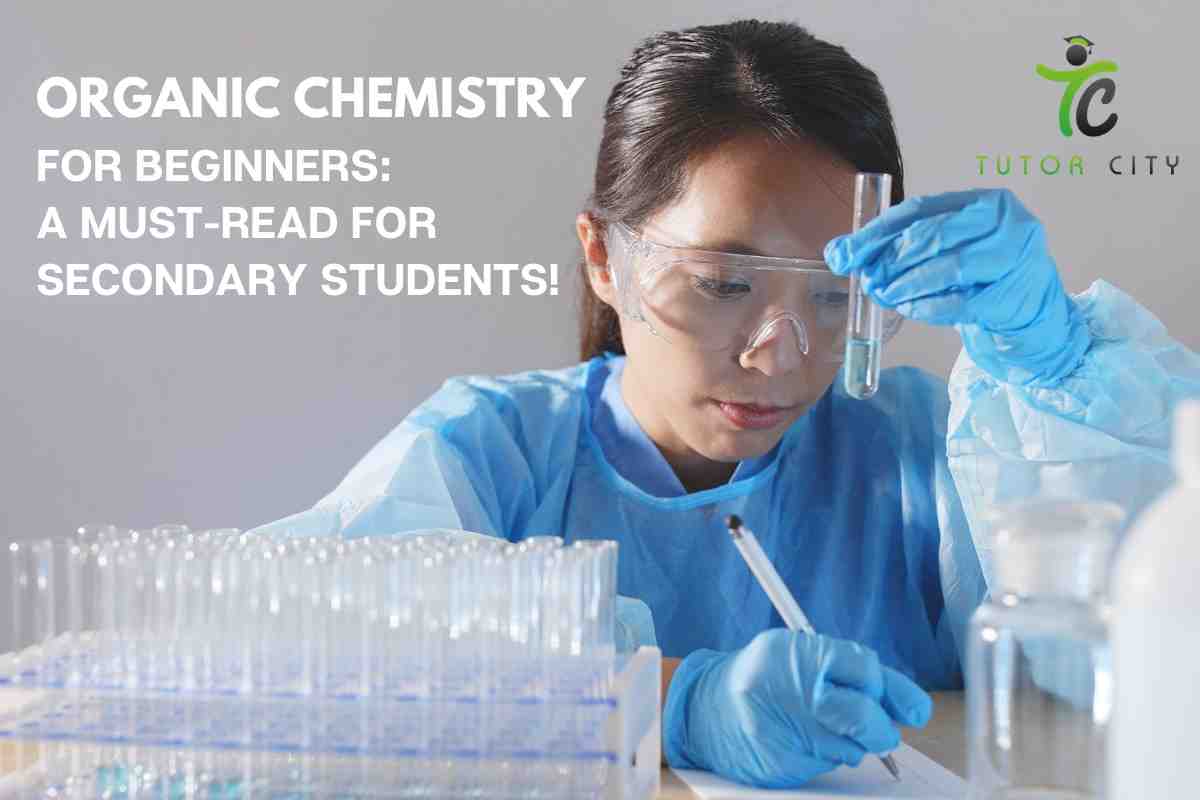
- Published by: Tutor City
- August 10, 2020
- Education
Organic Chemistry for Beginners: A Must-Read for Secondary students!
The study of organic chemistry is a branch of chemistry that focuses mainly on studying carbon molecules.
Organic chemistry studies how the carbon-containing compounds react to different substances, what their structure is, what their properties are, and their preparation.
Carbon is essential to all living creatures (although there are many nonliving objects that are made from carbon. E.g., plastic, pharmaceuticals, food, explosives, cosmetics, and various dyes).
Originally this branch of chemistry was limited to organic compounds only, but now it also studies the human-made substances as well.
1. Classification of organic compounds.
About 90 % of all compounds are organic. Broadly speaking, these compounds are categorized into acyclic (open-chain compounds) or cyclic (closed chain compounds).
The categorization depends on how the carbon atoms are arranged in the structure.
a. Acyclic compounds.
The carbon atoms here are arranged in the open-chain, which can either be straight or branched. These compounds were derived from animal or vegetable fat, and earlier, they were called Aliphatic compounds.
b. Cyclic compounds.
This structure consists of one or more rings of atoms. They can be further subdivided into two categories: carbocyclic compounds and heterocyclic compounds.
2. Organic reactions.
A vital part of organic chemistry is the study of organic reactions. There are several types of reactions. These are addition reaction, elimination reaction, substitution reaction, radical reaction, oxidation-reduction reaction.
During substitution, one atom (or a group of atoms) replaces another atom (or a group of atoms). This gives us a totally new substance. During the elimination reaction, the adjacent atoms are removed.
Multiple bonds are formed at the same time, and small molecules are released as a result.
The addition reaction is the opposite of the elimination reaction. As for the radicals (and their movement), they are involved in the majority of organic reactions.
Typically the radical reaction consists of three stages. These are initiation, propagation, and termination.
3. Chemical bonds.
Why do atoms bond?
The answer is simple; the compound that we get after atoms bond is more stable, and it is lower in energy than separate atoms.
When the bond happens, some of the energy is released. Thus you must put some energy in to break up the bond.
4. Carbon 101.
As we have already said, carbon is an essential element in all living (and some nonliving) lifeforms.
Fun fact: diamonds are carbon atoms that have crystallized over a long period of time; they are extremely hard because the atoms have bonded very tightly.
The carbon atom can combine with the maximum of four other atoms. So, the organic molecules that contain carbon can be rather large.
Carbons have four electrons in their outer shell. These electrons can bond with other atoms. For example, if carbon bonds with hydrogen, the resulting compound will be called hydrocarbon.
In living organisms, carbon atoms often bond with nitrogen, sulfur, and oxygen.
The reason organic chemistry is focused mainly on carbon is that this element has a chemical diversity that is unique to it. The chemical diversity is based on three factors.
Carbon atoms bond very well with other carbon atoms. Carbon atoms bond quite well with the atoms of other elements. The number of covalent bonds is large (four).
It is interesting that despite its undeniable importance, carbon is not one of the most abundant elements in the earth’s crust.
5. Alkanes (hydrocarbons).
Hydrocarbon is the simplest organic compound. There are several different kinds of hydrocarbons, which can be differentiated by the type of bond they form and their properties.
One of such hydrocarbons is an alkane. The three simplest alkanes are methane, ethane, and propane.
Alkanes make relatively few chemical reactions (except the combustion), and they also have relatively few properties. Because of this, many other organic compounds are often compared to alkanes.
In addition, alkane molecules are not soluble in water but are soluble in some other solvents. Also, the alkanes can be used as solvents for other organic substances (e.g., oil, wax, or fat). All alkanes are less dense than water.
Also, alkane molecules, in general, do not react with compounds such as oxidizing agents, reducing agents, or many laboratory acids.
This is because the alkanes are nonpolar. Combustion and halogenation are the reactions that the alkanes do undergo.
If the alkane is in contact with oxygen at room temperature, nothing happens. But if the energy is activated by a flame or a spark, we get combustion.
This alkane reaction causes many fatal accidents each year (mainly due to improperly adjusted gas or kerosene heaters in unventilated rooms).
Alkanes can also react with chlorine or bromine (which are halogens) and create a brominated alkane or a chlorinated alkane.
But in general, they do not react with many chemicals. For this reason, they are sometimes called paraffins (from the Latin expression meaning “little affinity”).
6. Isomerism.
Sometimes two or more compounds can have the same chemical formula but different structural formulas. The compounds that exhibit this phenomenon are called isomers.
There are two basic types of isomerism. These are stereoisomerism and structural isomerism.
If the isomers have the same molecular formula but different structures, they are structural isomers. If atoms are positioned differently but the molecular formula is the same, we are dealing with stereoisomerism (or spatial isomerism as it is sometimes called).
7. Purification
Organic compounds need to undergo a purification process. There are several methods to do that, but the choice of the method depends on the substance and whether it is solid or liquid. We also need to consider what kind of impurities we need to remove.
Common methods of purification are simple crystallization, fractional crystallization, simple distillation, steam distillation, azeotropic distillation, fractional distillation, distillation under reduced pressure, sublimation and chromatography.
These are the basic facts about organic chemistry. There are many more interesting phenomena that exist in this branch of science.
Trying to make sense of it all and memorizing all this information on your own may sometimes be confusing so, if you feel overwhelmed, fear not!
You can hire an experienced private chemistry tutor who will explain everything to you in meticulous detail and help you master the subject.






